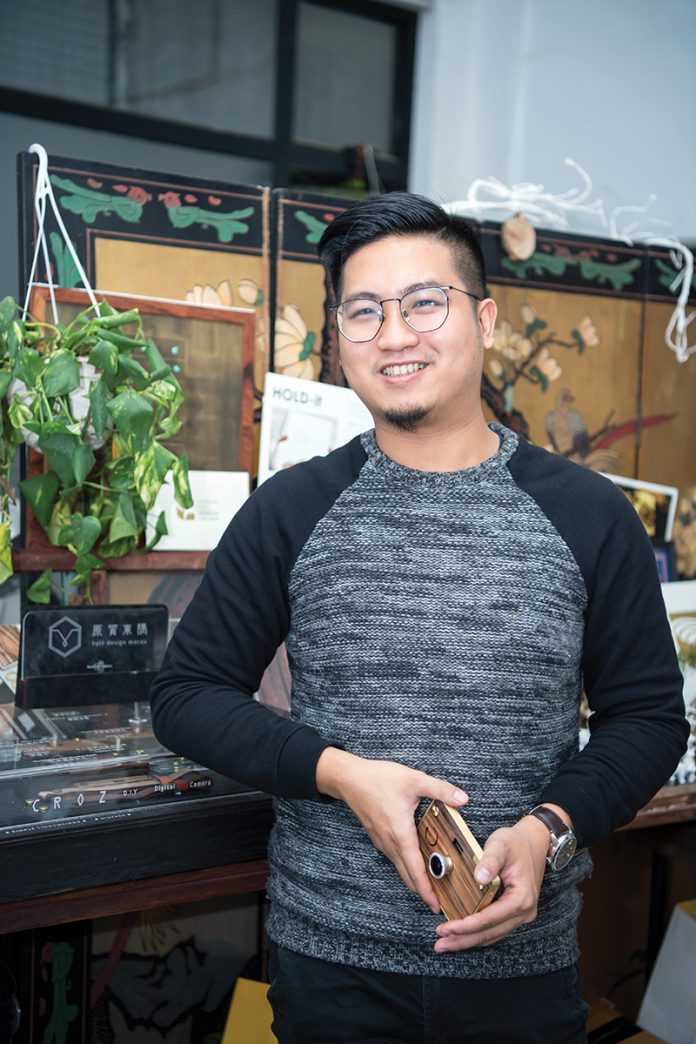By: Tony Lai
Photos by: Cheong Kam Ka
Every year, the world generates tens of millions of tonnes of wood waste in the production of various wood products. At a furniture factory in nearby Guangdong Province, heaps of rosewood waste can be seen lying around the premises, the detritus of furniture fetching over MOP1 million (US$125,000) a piece.
“I asked the people in the factory what they were going to do with the remains, who simply replied, ‘No, these cannot be used again’,” recalls local designer Calvin Sio Kai Tong of his experience in his relative’s furniture factory a few years ago.
“I wondered at the time whether this could still be utilised somehow,” said the designer, who is interested in collecting antiques. “When an item still has value it should not be wasted.”
 Later, Mr. Sio founded Hylé Design Macau, a design studio manufacturing lifestyle products with materials like wood. The wood waste from the Mainland factory has been given a second lease of life: being transformed into stylish cameras that are now sold around the world – from the Museum of Modern Art in New York to renowned French department store Galeries Lafayette. This metamorphosis underscores the core vision behind his studio: all things in their being are good for something .
Later, Mr. Sio founded Hylé Design Macau, a design studio manufacturing lifestyle products with materials like wood. The wood waste from the Mainland factory has been given a second lease of life: being transformed into stylish cameras that are now sold around the world – from the Museum of Modern Art in New York to renowned French department store Galeries Lafayette. This metamorphosis underscores the core vision behind his studio: all things in their being are good for something .
But Sio’s career has not been a smooth path. Studying industrial design and the cultural creative industry at university in Taiwan, he worked for design companies on that island and in Macau before starting his own studio. “I was confused and upset at the time because I was not doing what I wanted to do,” he said. “There was basically no job for industrial design in Macau at the time I came back.”
Following his stint of a few months in the furniture factory on the Mainland he was determined to establish his own studio in 2014. “I felt like if nobody was doing it [industrial design] why didn’t I do it myself,” he smiled, when speaking in his studio at the Macau Design Centre, where wood can be seen – and smelt – in every nook and cranny.
 Crowdfunding
Crowdfunding
Apart from the aspirations of the Mainland furniture factory, the usage of wood for products also has a pragmatic reason. “The cost of developing products with plastics, metals and other materials is higher, requiring larger investment input that is difficult for start-ups to do,” Mr. Sio explains. “The development cycle for wood products is also shorter compared with others that might take two to three years or more.”
In the first two years of operation, Hylé Design created stationery, accessories and small furniture pieces with wood, which were mostly kept out of the public eye. His studio has only attracted more attention locally – and even internationally – with the launch of Croz – D.I.Y Digital Camera at the end of 2016, which raised approximately HK$240,000 via crowdfunding platform Kickstarter.
“It is possibly the first crowdfunded project in Macau,” he remarked, with crowdfunding not a popular means of financing here given the abundance of financial support from the government for cultural creative firms or start-ups.
Although he had already produced the first batch of wooden cameras at the time of crowdfunding, Kickstarter gave Hylé Design other advantages. “It’s good for promotion,” he noted. “We wouldn’t have been able to be sold in the United Sates or France had we not gotten [together with] Kickstarter – the Museum of Modern Art in New York and Galeries Lafayette only got our products after we crowdfunded at Kickstarter.”
The crowdfunded platform also offers the design studio a complete profile of its customers, namely their preferences and consumption amount. “In this big data era, it can tell us exactly what types of product are more sought after by customers . . . and help us to improve our products,” said Sio.
 Custom cameras
Custom cameras
With more than 3,500 cameras sold in Macau, Hong Kong, Taiwan, Japan, France and the U.S. since the launch more than a year ago, Croz – D.I.Y Digital Camera – a collaboration between Hylé Design and Taiwanese camera label Paper Shoot – will undergo a major upgrade this year, such as a better resolution camera lens.
Unlike conventional cameras that focus on complex features and functions, Croz cameras are more straightforward with just two buttons: one for power and shooting, and one for filter effects. Highlighting the design of the camera itself, Croz cameras, sold at some MOP1,000 each, come in different sets of wooden case, brass frame, camera board, memory card, lens and other elements whereby users can assemble their cameras in four to six steps within minutes.
“Sales match our expectations because we didn’t produce a lot in the beginning,” he said. “The supply once stopped for about one to two months given the [fervent] demand.”
“Non-local sales, namely from Hong Kong, amounted to a bigger share of total sales in the beginning but the Macau sales have got better over time,” the designer continued. “Some locals have told me they have bought our products overseas . . . showing locals quite support Macau products.”
Striving to sell 7,000 to 10,000 cameras this year, Mr. Sio hopes to set up an online platform in future on which customers can choose components from lens to case to frame at each step, allowing them to order their customised camera. “We’ve wanted to do this since the very beginning but we have not yet had this capability,” he said. “We hope we can do so when the operation becomes more mature.”
 Collaboration
Collaboration
In addition to selling more cameras this year and the imminent launch of a customised platform, Hylé Design aims to assemble more projects under the umbrella of the Croz brand, which means a crossover of Hylé Design with other brands similar to Croz cameras. Croz is a brand, in fact, that Sio says strives to resolve the problems industrial design brands and companies might face; namely, lack of design, resources and techniques.
“For instance, your company might have excellent technique without design, while my company might have good design but lack technique, so we can collaborate,” he illustrated. “It’s very similar to the concept of sharing economy . . . that we can share designs, techniques and resources under the Croz brand.” In the wake of the inaugural project, the Croz cameras, with Taiwanese Paper Shoot, he wishes to work with Macau brands for other products under Croz in the future.
Opening a physical shop exclusively dedicated to products of Hylé Design is also one of his long-term goals. Currently, the studio has only a few physical sales points in venues like Macau Design Centre in the city. “But we will only do so when we have more products, as we want the shop to sell only our products, not the products of other labels,” he added.
Starting with education
The designer also hopes to work with schools in the future to provide workshops for youngsters to cultivate their interests, skills and creative thinking in regard to industrial design and other creative fields.
“For the development of the local cultural creative industry, money and subsidies are simply not enough,” Sio observed. “[My experience] tells me that there’s not enough talent, requiring more cultural creative education for individuals at a young age.”
His passion for contributing to the development of the local cultural creative industry has been foretold in the Chinese name of Hylé Design, Jyun Zat Dung Jyu. “Jyun Zat means what we are doing is very simple, while Dung Jyu is the term of place for sunrise in ancient Chinese,” he explained. “We want customers to feel our passion through our products, which can also shed light on the development of the local cultural creative industry.”
What is crowdfunding?
Crowdfunding is an alternative form of financing, a practice in which the funding of a project or a company is raised by many small amounts of capital contributed by a large number of people. Given the prevalence of the Internet over the past two decades, crowdfunding has become increasingly popular as a means of financing, particularly for start-ups, with the inception of numerous online crowdfunding platforms such as Kickstarter, Crowdfunder and GoFundMe.
According to Kickstarter, a New York-based crowdfunding website, it has received nearly US$3.48 billion from 14.12 million backers for over 138,000 successfully funded projects as of now since its establishment in 2009. Most successfully funded projects, or two-thirds of the total, are projects seeking less than US$10,000 its data shows.
























